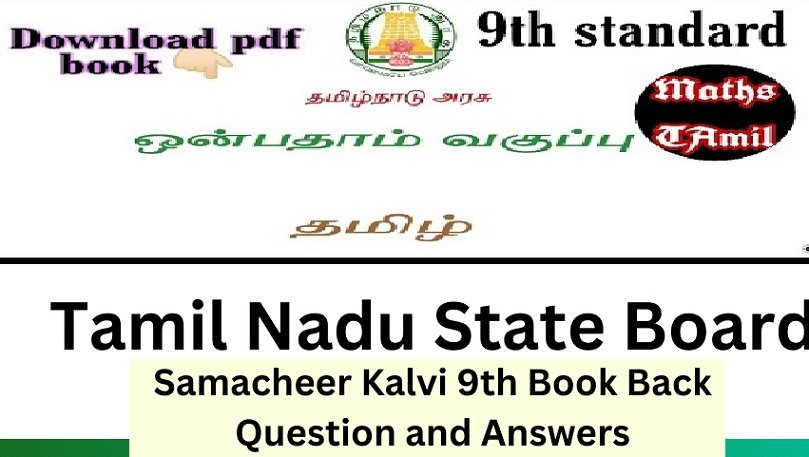A Complete Guide to the 9th Tamil Book
The 9 th Tamil book is a pivotal resource for students in Tamil Nadu, designed to enrich their understanding of Tamil language, literature, and culture. This textbook, aligned with the Tamil Nadu State Board syllabus, helps students explore classical and modern Tamil literature, grammar, and composition. Whether you’re a student preparing for exams or an educator aiming to guide your class effectively, this guide covers everything you need to know.
Table of Contents
- Introduction to the 9 th Tamil Book
- Overview of the Chapters
- Key Highlights of Prose, Poetry, and Supplementary Reading
- Grammar and Writing Skills
- Study Tips for Students
- Important Exam Questions and Topics
- FAQs About the 9th Tamil Book
- Conclusion
1. Introduction to the 9th Tamil Book
The 9th Tamil book serves as a comprehensive tool for enhancing students’ language proficiency. It not only delves into the beauty of Tamil literature but also develops critical thinking and writing skills. With a mix of traditional and contemporary content, the book fosters a deep appreciation for Tamil heritage.
2. Overview of the Chapters
The book consists of prose, poetry, supplementary reading, and grammar sections. Here’s an overview:
| Section | Content | Focus Area |
|---|---|---|
| Prose | Stories and essays by renowned Tamil authors, exploring culture, values, and social themes. | Enhancing comprehension and analytical skills. |
| Poetry | Classical and modern Tamil poems that highlight the language’s richness and artistic expression. | Developing appreciation for poetic techniques and themes. |
| Supplementary | Short stories and plays designed to boost creative thinking and engagement. | Encouraging imagination and connecting with diverse literary forms. |
| Grammar | Tamil grammar, including parts of speech, sentence formation, and idioms. | Strengthening language structure and usage. |
| Composition | Essay and letter writing, comprehension exercises, and dialogue writing. | Cultivating writing proficiency and clarity. |
3. Key Highlights of Prose, Poetry, and Supplementary Reading
Prose Highlights
The prose section introduces thought-provoking themes like cultural identity, social harmony, and environmental conservation. Notable chapters include:
- “Tamil Mozhiin Mugam”: Discusses the evolution and beauty of the Tamil language.
- “Thaneer Thaneer”: A compelling story that sheds light on water scarcity in rural areas.
- “Naadiya Veliyil”: Explores the importance of education and perseverance in achieving success.
Poetry Highlights
The poetry section celebrates Tamil’s poetic heritage. Key poems include:
- “Purananuru – Nadunattu Pulavar”: Highlights the values of bravery and sacrifice in Tamil culture.
- “Kannadasan Kavithaigal”: Showcases themes of love, spirituality, and human connection.
- “Vaazhviyal Kavidhaigal”: Focuses on everyday struggles and joys.
Supplementary Reading Highlights
Supplementary stories and plays encourage students to think critically. Important works include:
- “Nallathor Veenai”: A moving story about selflessness and family bonds.
- “Thennang Keezhalin Sirukathaigal”: A collection of short stories with moral lessons.
4. Grammar and Writing Skills
The grammar section is crucial for mastering the Tamil language. Topics include:
- Parts of Speech: Understanding nouns, verbs, adjectives, and adverbs in Tamil.
- Sentence Formation: Structuring simple, compound, and complex sentences.
- Idioms and Proverbs: Enriching language with common Tamil expressions.
The writing skills section focuses on essay writing, letter drafting, and creative exercises.
| Grammar Topic | Examples | Purpose |
|---|---|---|
| Noun Forms | Paadam (Lesson), Kavi (Poet) | Recognizing and using nouns correctly. |
| Tenses | Present, Past, Future | Understanding and applying verb conjugations. |
| Proverbs | “Thirai Kadal Odiyum Thiraviyam Thedu” | Learning cultural values through language. |
5. Study Tips for Students
- Plan Your Study Schedule: Allocate time for prose, poetry, grammar, and writing practice.
- Use Flashcards for Grammar: Memorize idioms, proverbs, and sentence patterns.
- Practice Writing: Write essays and letters to improve clarity and structure.
- Summarize Chapters: Write short summaries of each chapter to reinforce understanding.
- Group Discussions: Discuss themes and interpretations with peers to gain new perspectives.
6. Important Exam Questions and Topics
Prose
- What are the key messages in “Tamil Mozhiin Mugam”?
- Analyze the character development in “Thaneer Thaneer.”
Poetry
- Explain the themes in “Purananuru – Nadunattu Pulavar.”
- Discuss the poetic devices used in “Vaazhviyal Kavidhaigal.”
Grammar
- Construct sentences using the following idioms: “Kannodu Kanbathellam Poi.”
- Identify the tense in the given sentences and rewrite them in another tense.
7. FAQs About the 9th Tamil Book
Q1: Is the 9th Tamil book difficult to study?
A1: With a proper study plan and consistent effort, students can master the material easily.
Q2: What resources can complement the 9th Tamil book?
A2: Reference guides, online tutorials, and teacher notes can be useful.
Q3: How can parents support students in studying Tamil?
A3: Parents can encourage regular reading and discussion of Tamil literature at home.
8. Conclusion
The 9th Tamil book is more than just a textbook—it’s a gateway to the rich linguistic and cultural heritage of Tamil Nadu. By diving into its prose, poetry, and grammar sections, students not only prepare for exams but also develop a lifelong love for the Tamil language. With structured study and the tips shared here, mastering the content becomes an achievable goal.
